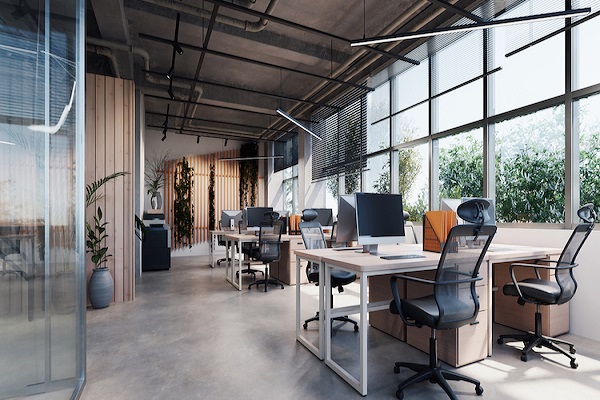The design of commercial spaces plays a pivotal role in shaping the work environment, influencing productivity, and reflecting a company's identity. Within this dynamic landscape, the choice of furniture becomes a crucial aspect, and commercial metal furniture emerges as a versatile and enduring option that seamlessly blends style with durability. In this exploration, we delve into the world of commercial metal furniture, examining how it has become a cornerstone in workspace design, offering a perfect union of aesthetics and functionality.
The Rise of Commercial Metal Furniture
The utilization of metal in furniture design has a rich history dating back centuries. Traditional metal work often showcased intricate designs in wrought iron or brass, emphasizing craftsmanship and durability. However, the evolution of commercial metal furniture has been particularly notable in the modern era, where advancements in manufacturing processes and design principles have elevated metal to a leading role in contemporary workspace aesthetics.
Aesthetic Versatility
Commercial metal furniture boasts a remarkable range of design possibilities, from minimalist and industrial styles to sleek, modern aesthetics. Steel, aluminum, and other metals provide designers with a versatile canvas to create furniture that compliments diverse office environments. Whether it's the clean lines of metal-framed desks, the geometric allure of metal shelving units, or the sophistication of metal-framed chairs, the aesthetic versatility of commercial metal furniture allows for customization to suit different design preferences.
Durability Beyond Trends
One of the key contributors to the durability of commercial metal furniture is the use of cold rolled steel—a material celebrated for its strength, resilience, and versatility. Beyond its visual appeal, the durability of it makes it an attractive choice for commercial spaces. In high-traffic areas such as offices, cafes, or co-working spaces, furniture undergoes constant use. Commercial metal furniture, crafted from robust materials, withstands the rigors of daily life, ensuring longevity and minimizing the need for frequent replacements. This durability translates into cost-effectiveness for businesses, making metal furniture a practical investment with a lasting impact.
Sustainability in Design
As sustainability gains prominence in design considerations, commercial metal furniture takes center stage. Metals like steel and aluminum are highly recyclable, making them environmentally friendly choices for businesses committed to reducing their ecological footprint. Additionally, the durability of metal furniture contributes to a longer lifespan, reducing the overall environmental impact associated with the manufacturing and disposal of furniture.
Ergonomics and Comfort
The design of workspaces has evolved to prioritize employee well-being and comfort. Commercial metal furniture, once associated primarily with industrial settings, has adapted to meet ergonomic standards. From adjustable metal-framed chairs with lumbar support to metal workstations designed for optimal functionality, contemporary metal furniture aligns with the ergonomic needs of modern professionals, fostering a healthier and more comfortable work environment.
Collaborative Spaces
The shift toward open office concepts has redefined the dynamics of collaborative workspaces. Commercial metal furniture plays a crucial role in shaping these environments, providing adaptable solutions for collaborative zones. Metal-framed benches, communal tables, and modular seating arrangements offer flexibility and mobility, encouraging teamwork and interaction among employees.
Brand Identity and Customization
In the realm of commercial design, brand identity is a key consideration. Metal furniture provides an ideal canvas for customization, allowing businesses to incorporate their brand colors, logos, or unique design elements into their furniture pieces. Custom metal furniture becomes more than just functional; it becomes a statement piece that reinforces the company's identity and culture within the workspace.
Space Optimization
Many modern workplaces face the challenge of optimizing limited space. Commercial metal furniture addresses this challenge with its space-efficient designs. Metal-framed desks with built-in storage, wall-mounted metal shelving, and modular metal workstations are examples of how metal furniture contributes to effective space utilization without compromising on style or functionality.
Maintenance and Cleanliness
In high-traffic commercial spaces, the ease of maintenance is a practical consideration. Metal furniture, known for its resistance to stains and easy cleaning, offers a hygienic solution for businesses. Regular maintenance involves simple cleaning routines that help uphold the aesthetic appeal of metal furniture, ensuring that it remains a pristine addition to the workspace.
Trendsetting Designs
Contemporary designers are pushing the boundaries of conventional furniture design, turning metal pieces into focal points within commercial interiors. Statement-making metal tables, artistic metal partitions, and sculptural metal installations contribute to a visually dynamic and engaging atmosphere, reflecting the creativity and innovation inherent in the business.
Seamless Integration with Technology
As technology becomes an integral part of the modern workspace, commercial metal furniture seamlessly integrates with digital advancements. Metal-framed desks with cable management solutions, charging stations integrated into metal tables, and smart furniture designs that accommodate technology contribute to the tech-savvy nature of contemporary commercial environments.
Conclusion
In the ever-evolving landscape of commercial design, metal furniture has secured its place as a durable, stylish, and adaptable choice. Its aesthetic versatility, durability, and sustainability make it a preferred option for businesses aiming to create workspaces that not only look impressive but also prioritize practicality and employee well-being. As commercial metal furniture continues to evolve, it stands as a testament to the marriage of style and functionality, enriching the workspaces of today and setting the stage for the offices of tomorrow.

No comments:
Post a Comment